
Manzanar is the site of one of ten American concentration camps, where more than 120,000 Japanese Americans were incarcerated during World War II from March 1942 to November 1945. Although it had over 10,000 inmates at its peak, it was one of the smaller internment camps. It is located at the foot of the Sierra Nevada mountains in California's Owens Valley, between the towns of Lone Pine to the south and Independence to the north, approximately 230 miles (370 km) north of Los Angeles. Manzanar means "apple orchard" in Spanish. The Manzanar National Historic Site, which preserves and interprets the legacy of Japanese American incarceration in the United States, was identified by the United States National Park Service as the best-preserved of the ten former camp sites.

During World War II, the United States, by order of President Franklin D. Roosevelt, forcibly relocated and incarcerated at least 125,284 people of Japanese descent in 75 identified incarceration sites. Most lived on the Pacific Coast, in concentration camps in the western interior of the country. Approximately two-thirds of the inmates were United States citizens. These actions were initiated by Executive Order 9066 following Imperial Japan's attack on Pearl Harbor. Like many Americans at the time, the architects of the removal policy failed to distinguish between Japanese immigrants and Japanese Americans. Of the 127,000 Japanese Americans who were living in the continental United States at the time of the Pearl Harbor attack, 112,000 resided on the West Coast. About 80,000 were Nisei and Sansei. The rest were Issei immigrants born in Japan who were ineligible for U.S. citizenship under U.S. law.

The Civil Liberties Act of 1988 is a United States federal law that granted reparations to Japanese Americans who had been wrongly interned by the United States government during World War II and to "discourage the occurrence of similar injustices and violations of civil liberties in the future". The act was sponsored by California Democratic congressman and former internee Norman Mineta in the House and Hawaii Democrat Senator Spark Matsunaga in the Senate. The bill was supported by the majority of Democrats in Congress, while the majority of Republicans voted against it. The act was signed into law by President Ronald Reagan.
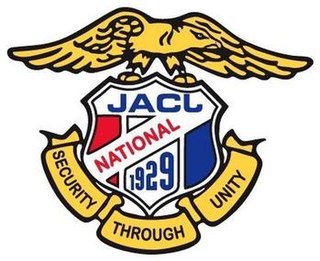
The Japanese American Citizens League is an Asian American civil rights charity, headquartered in San Francisco, with regional chapters across the United States.
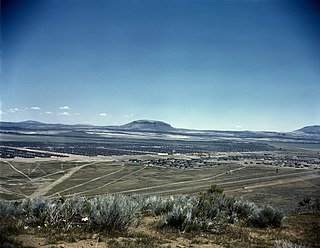
The Tule Lake National Monument in Modoc and Siskiyou counties in California, consists primarily of the site of the Tule Lake War Relocation Center, one of ten concentration camps constructed in 1942 by the United States government to incarcerate Japanese Americans forcibly removed from their homes on the West Coast. They totaled nearly 120,000 people, more than two-thirds of whom were United States citizens. Among the inmates, the notation "鶴嶺湖" was sometimes applied.
The following article focuses on the movement to obtain redress for the internment of Japanese Americans during World War II, and significant court cases that have shaped civil and human rights for Japanese Americans and other minorities. These cases have been the cause and/or catalyst to many changes in United States law. But mainly, they have resulted in adjusting the perception of Asian immigrants in the eyes of the American government.
Nisei is a Japanese-language term used in countries in North America and South America to specify the ethnically Japanese children born in the new country to Japanese-born immigrants. The Nisei are considered the second generation and the grandchildren of the Japanese-born immigrants are called Sansei, or third generation. Though nisei means "second-generation immigrant", it often refers to the children of the initial diaspora, occurring in the late 19th and early 20th centuries, and overlapping with the G.I. and silent generations.
Togo W. Tanaka was an American newspaper journalist and editor who reported on the difficult conditions in the Manzanar camp, where he was one of 110,000 Japanese Americans who had been relocated after the Japanese attack on Pearl Harbor on December 7, 1941.
Edison Tomimaro Uno was a Japanese American civil rights advocate, best known for opposing laws used to implement the mass detention of Japanese Americans during World War II and for his role in the early stages of the movement for redress after the war. To many Japanese American activists, Uno was the father of the redress movement.
James Yutaka Matsumoto Omura was the English language editor of the Rocky Shimpo newspaper in Denver, Colorado, during World War II. He was an outspoken critic of the expulsion of people of Japanese ancestry from the west coast of the United States to concentration camps, following the Japanese attack on Pearl Harbor. Subsequently, he became a vocal champion of the Nisei draft resisters, providing a 'substantial anchor' to the work of the Heart Mountain Fair Play Committee by publishing their grievances in the Rocky Shimpo. At a time when the Japanese American Citizens League (JACL) preached passive conformity with the federal government as the best policy, Omura became the JACL's arch-enemy for counseling active resistance.
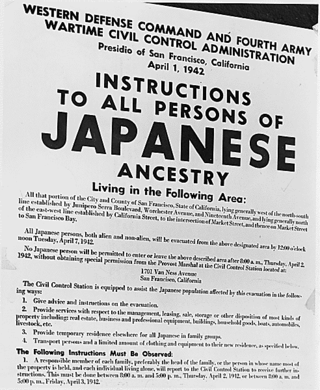
The Day of Remembrance is a day of observance for the incarceration of Japanese Americans during World War II. Events in numerous U.S. states, especially in the West Coast, are held on or near February 19, the day in 1942 that Executive Order 9066 was signed by President Franklin D. Roosevelt, requiring internment of all Americans of Japanese ancestry.Events are not only relegated to the West Coast and it is widely observed in areas such as New England, Chicago, Alaska, Philadelphia, and New York.
The Japanese American Committee for Democracy was an organization during and after World War II.
Aiko Herzig-Yoshinaga was a Japanese American political activist who played a major role in the Japanese American redress movement. She was the lead researcher of the Commission on Wartime Relocation and Internment of Civilians (CWRIC), a bipartisan federal committee appointed by Congress in 1980 to review the causes and effects of the Japanese American incarceration during World War II. As a young woman, Herzig-Yoshinaga was confined in the Manzanar Concentration Camp in California, the Jerome War Relocation Center in Arkansas, and the Rohwer War Relocation Center, which is also in Arkansas. She later uncovered government documents that debunked the wartime administration's claims of "military necessity" and helped compile the CWRIC's final report, Personal Justice Denied, which led to the issuance of a formal apology and reparations for former camp inmates. She also contributed pivotal evidence and testimony to the Hirabayashi, Korematsu and Yasui coram nobis cases.
The Heart Mountain Fair Play Committee was a group organized in 1943 to protest the draft of Nisei, from Japanese American concentration camps during World War II. Kiyoshi Okamoto formed a "Fair Play Committee of One" in response to the War Relocation Authority's controversial loyalty questionnaire in 1943, and was later joined by Frank Emi and other inmates of the Heart Mountain camp. With seven older leaders at its core, the Committee's membership grew as draft notices began to arrive in camp. To challenge their forced "evacuation" by the government, they refused to volunteer or participate in the draft, but the Committee required its members to be citizens loyal to the United States willing to serve if their rights were restored. By June 1944, several dozen young men had been arrested and charged by the U.S. government with felony draft evasion. While the camp at Poston, Arizona produced the largest group of draft resisters, at 106, the Fair Play Committee was the most prominent inmate organization to protest the draft, and the rate of draft resistance at Heart Mountain was the highest of any camp. The number of resisters eventually numbered nearly 300 from all ten camps.
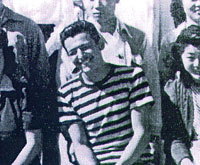
Ralph Lazo was the only known non-spouse, non-Japanese American who voluntarily relocated to a Japanese American internment camp during World War II. His experience was the subject of the 2004 narrative short film Stand Up for Justice: The Ralph Lazo Story.
Grayce Uyehara, née Kaneda, was a Japanese-American social worker and activist who led the campaign for a formal government apology for Japanese-American internment during World War II.
Isamu 'Art' Carlos Shibayama was a Peruvian-American civil rights activist who fought for the rights of Latin Americans of Japanese ancestry who were illegally interned in the United States during World War II.
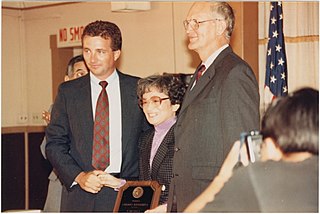
Cherry Kinoshita was a Japanese American activist and leader in the Japanese American Citizens League (JACL). She helped found the Seattle Evacuation Redress Committee and fought for financial compensation for Japanese Americans who had been incarcerated during World War II.
Frank Fujio Chuman is a Japanese-American former civil rights attorney and author, involved in several important Japanese American civil rights cases and in the redress movement.
Guyo Tajiri was a Japanese American journalist. She was the first Asian-American woman accepted to the University of Missouri School of Journalism. She also worked to transform the Pacific Citizen as an editor, a major Japanese American publication.







